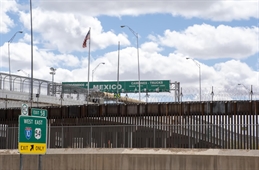
A combination of supply chain disruptions, rising costs and congested networks is causing a growing number of U.S. companies to shift some of their sourcing out of Asia to the Americas.
In their wake, Chinese manufacturers are establishing a foothold in Mexico to maintain their exports to U.S. customers.
U.S. importers’ appetite for Chinese products appears to be waning. At the end of November, U.S. manufacturing orders from China were down a massive 40% year-on-year according to the CNBC Supply Chain Heat Map data published on December 4.
Amidst signs of a drastic slowdown in imports, there were predictions that the traditional surge preceding the Lunar New Year break would not materialize this time, with Chinese manufacturers reportedly closing their facilities early in response to weak demand.
The slump in December marked an acceleration of a downward trend that started earlier. According to supply chain research firm Project44, container volume from China to the U.S. suffered a 21% decline between August and November.
Excess inventory levels, predictions of slowing consumer demand and disruptions in China from lockdowns have taken a toll on traffic from China to the U.S., but there are growing signs that an increasing number of U.S. firms are looking to make lasting shifts in their sourcing away from China.
Not all categories have shown a contraction. Shipments of lithium-ion batteries from China to the U.S. have actually grown.
In response to ongoing problems and the lockdowns of the past year under Beijing’s Zero-Covid policy as well as because of rising costs in China, there has been a steady shift of production to neighbouring Asian countries, which is continuing, but U.S. firms are showing an increasing desire to locate production closer to market.
A survey published last summer by technology firm ABB found that 70% of US businesses were looking to bring production closer to the U.S. While 33% were thinking of nearshoring, 37% were thinking of actually bringing production back to the U.S.
This tallies with the findings in the Kearney 2021 Nearshoring Index that was published last summer, which shows that 79% of companies with manufacturing in China had either moved part of their production back or were planning to do so within three years.
According to ABB, the biggest driver for this was a need for flexibility and resilience. Some executives expressed a sentiment of being fed up with disruptions and delays.
Disruptions from lockdowns and from congested facilities have played a large role in the rise in nearshoring interest, but the rising costs of production in China have also been a factor.
Apart from the higher costs in China, firms have had to grapple with the tariffs slapped on many Chinese products. By one estimate, the U.S. has levied duties on more than US$300 billion worth of imports from China.
Countries closer to the U.S. are sensing opportunities. Ocean carriers serving trade lanes between the U.S. and countries in the Caribbean and in Latin America have reported growing traffic flows on these sectors related to nearshoring.
This is aided by the return of vessel capacity to those markets in recent months, which had shifted to Asian routes during the past two years in response to soaring demand and rates.
Mexico is widely depicted as the front-runner in the nearshoring push. The Reshoring Institute has reported a construction boom on both sides of the U.S.-Mexico border, which is driven on the southern side by growth in the manufacturing of goods destined for the U.S. market.
Firms that have been setting up production plants there are not only U.S. or Mexican players, but also Asian companies targeting the U.S. market.
“Contract manufacturers such as Flex, Foxconn, Jabil and others have built factories near the border to take advantage of low-cost labour for production of goods bound for the U.S. In addition, Chinese-owned factories are being built at a fast pace. This is not merely a pass-through of Chinese goods being shipped to the U.S. from Mexico, but instead the building and operating of border factories that employ Mexican workers and assemble Mexican raw materials into finished products completely made in Mexico,” the institute noted.
This trend is bound to cause some concern at the port complex of Los Angeles and Long Beach, which has been the largest gateway for U.S. imports from Asia.
The ports have suffered declines in cargo volumes in recent months as importers shifted traffic to ports on the U.S. East and Gulf Coasts to avoid fallout from a possible work stoppage at West Coast ports. By some estimates, as much as 10% of that volume may be lost for good for Los Angeles and Long Beach. The last thing the operators want to see now is a loss of Asian cargo flows to Mexican gateways.
It will take time for such shifts to fully manifest themselves. Abe Eshkenazi, CEO of the Association for Supply Chain Management in Chicago, stressed that nearshoring is a long-term trend, as complex supply chains cannot be reconfigured at short notice.
A lot of the efficiencies in sourcing from China cannot be replicated in the short run.
The country has a well-built-out logistics infrastructure and a trained workforce that rival locations require time to build up. Many upstream suppliers of parts that go into parts and widgets are located in smaller Chinese cities. These are hard to replace, and they would find it difficult to relocate overseas.
Still, the writing is on the wall.
By Ian Putzger
Correspondent | Toronto



